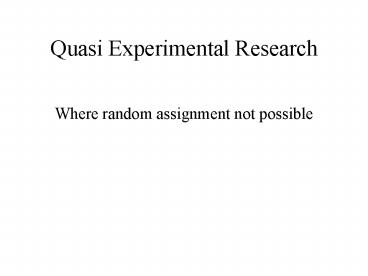Quasi Experimental Research - PowerPoint PPT Presentation
1 / 17
Title:
Quasi Experimental Research
Description:
X=treatment/intervention, O=observation/measurement, NR=non randomized assignment ... Avoid using big words, e.g., 'groundbreaking,' unless it is truly groundbreaking. ... – PowerPoint PPT presentation
Number of Views:428
Avg rating:3.0/5.0
Title: Quasi Experimental Research
1
Quasi Experimental Research
- Where random assignment not possible
2
Categories
- Non-equivalent-groups research
- Time series research
- Single case experimental design
- Alternative single case design
- Correlational research
- Cross-lagged panel design
- Longitudinal design with cohorts
3
- Non-equivalent-groups research
- Like pretest-posttest randomized experimental
design, but without - the random assignment
- Pick intact groups/subjects you think are
similar. How? - Group1 NR O X O
- Group2 NR O O
- Xtreatment/intervention, Oobservation/measuremen
t, NRnon randomized assignment
4
- Why not random assignment?
- Ethical considerations
- Use of historical control group. Problem.
- Random assignment with wait-list controls
5
Moderator Variable
- Whats a moderator?
- Variables that affect magnitude (strength,
direction) of given relationship. - Race, sex, class, levels of award, etc.
- Represented as interaction effect in ANOVA
- Specifies when certain effects will hold.
- Baron, R.M. Kenny, D.A. (1986). The
moderator-mediator variable distinction in social
psychology research Conceptual, Strategic, and
statistical considerations. JPSP, 51, 1173-1182. - Example
- Alice Eaglys meta analyses.
- Raudenbushs meta analyses of the Pygmalion
Effect
6
Mediator Variable
- Not to be confused with Moderator variable.
- Accounts for relationship between two variables.
- Example
- Social class and cancer screening. Age
moderator. Education mediator.
7
Interrupted Time Series Design
- Single group pretested and posttested multiple
times, before and after the measure - OOOOXOOOO
- Interrupted a treatment is introduced
- Time series a single data point across time
- Example
- Berkowitz Macaulay study (1971) violent crime
and copycats - Philips King (1988, 1990) mortality rate and
holidays - Threat to internal validity
8
(No Transcript)
9
Variants of Interrupted Time-Series Designs
- Interrupted time-series design
- Single case experimental design
- Alternative single case experimental design
10
Single-Case Experimental Design
- Small-N (or N-of-1) experimental design
- Only one or a few units are studied
- Basic model ABA design equivalent to OXO
- Example behavioral modification
- (insert figure here)
11
- ABABA (OXOXO)
- Any study you can conduct using this design?
12
Alternative Single-Case Design
- Basic model ABA
- one treatment/natural event administered/happened
once - Other versions
- one treatment administered more than once
- ABABA
- More than one treatment administered
- A-B-BC-B
13
Correlational Designs
- Example Weisberg (1994), madness and creativity
14
Cross-lagged Panel Designs
- A correlational design
- Modeling technique of behavior at two different
points in time - 6 correlations are obtained
- Attempt to derive causal relationships based on
the correlations - Lagged delayed (longitudinal)
- Crossed correlational
- Panel study longitudinal
15
example
Test-retest correlation, synchronous correlation,
cross-lagged correlation
16
Longitudinal Design Using Cohorts
- Cohorts people sharing similar characteristics
or experience - Generation gap
- A generation defined as 20yrs.
- Cross sectional vs longitudinal
17
Critique of Literature
- Briefly summarize what was studied
- Critique selectively on whats problematic with
the paper, e.g., rationale of hypotheses, the
significance of the study, the clarity of
presentation, the method of the study, the
results, the conclusions drawn, the
interpretations of the findings. - But dont focus on everything.
- When needed, ask for clarifications.
- The purpose is to critique the study, and not to
say how much you agree with it. - Be realistic in your critique. A single study
cannot be expected to answer all the questions
and cover all areas. - If you do find it a great study with little room
for improvement, say so, but back it back with
justifications. - Avoid using big words, e.g., groundbreaking,
unless it is truly groundbreaking.































